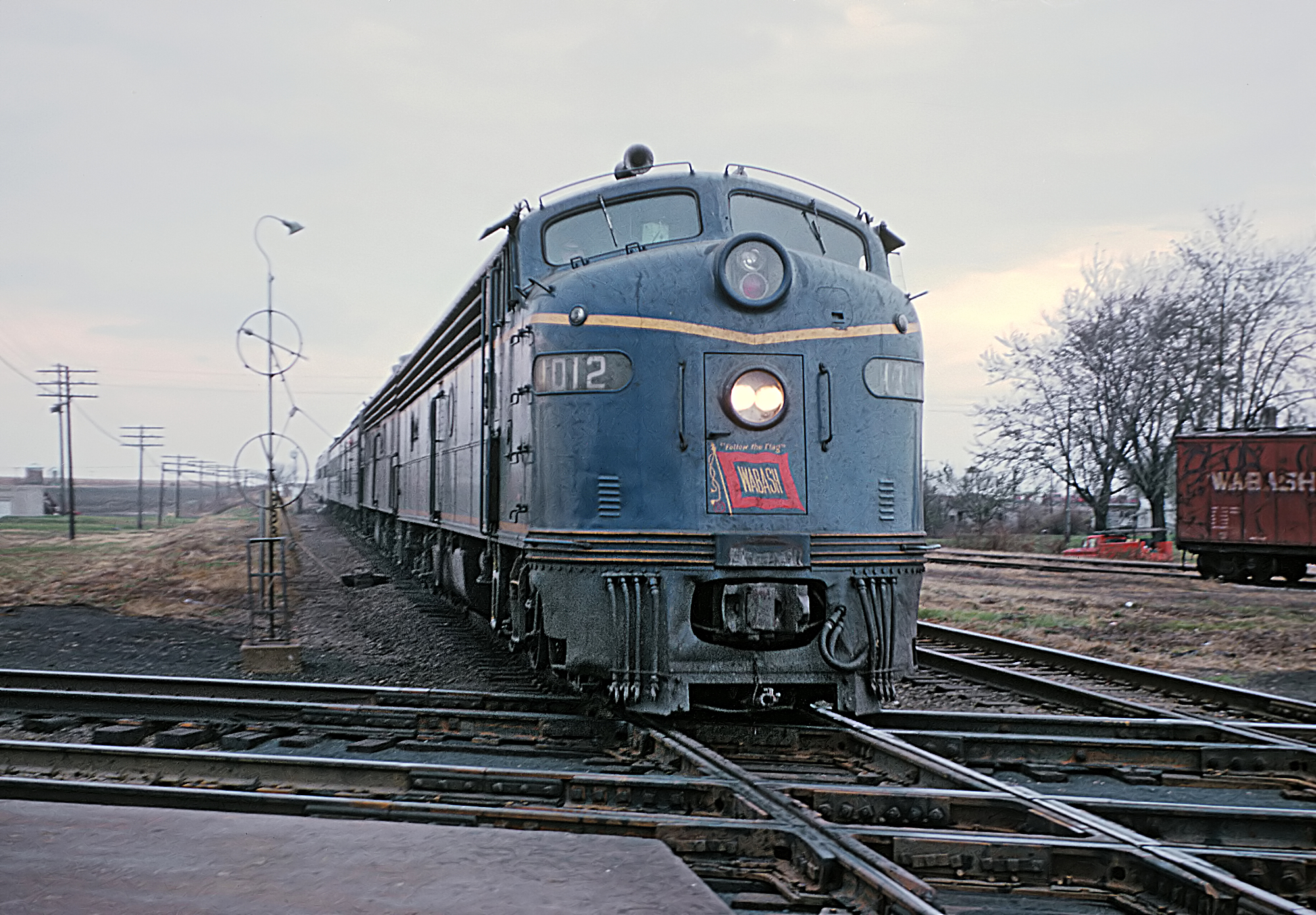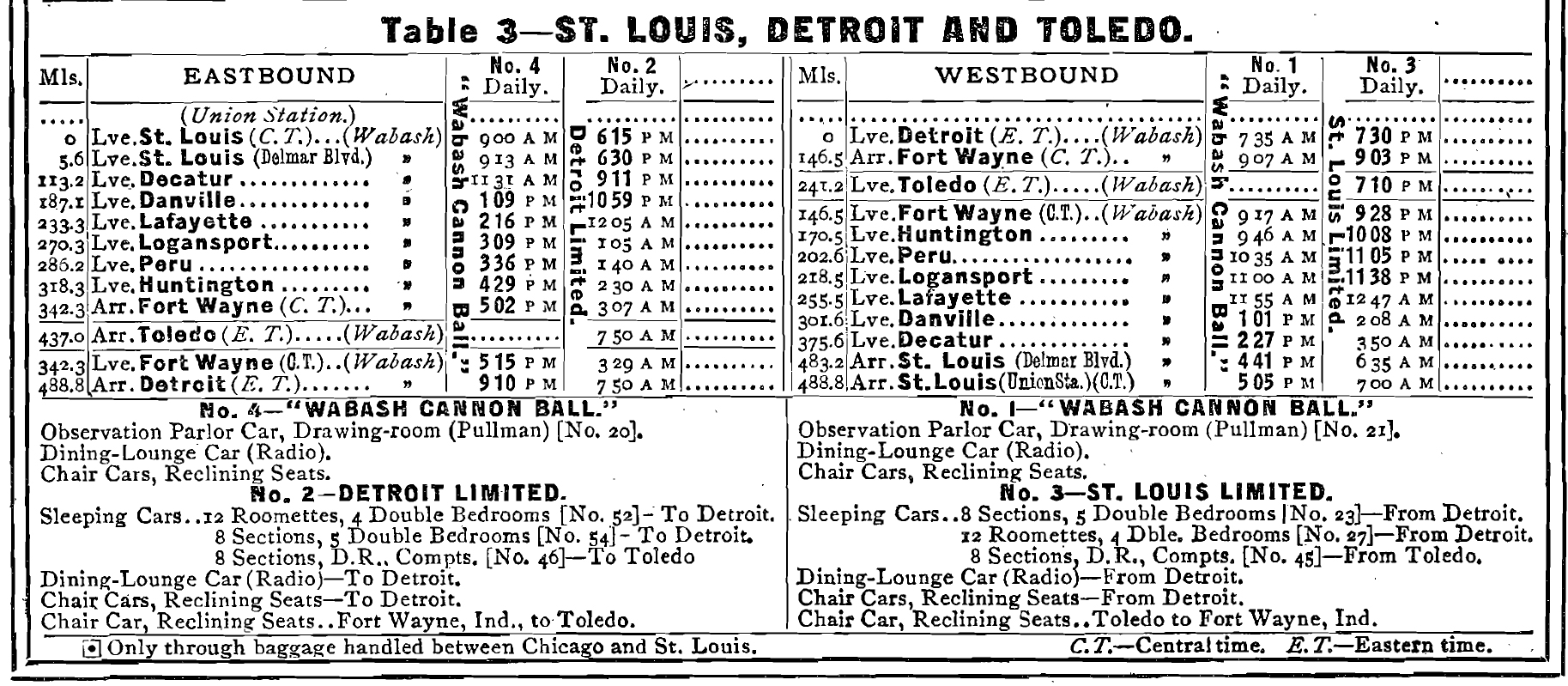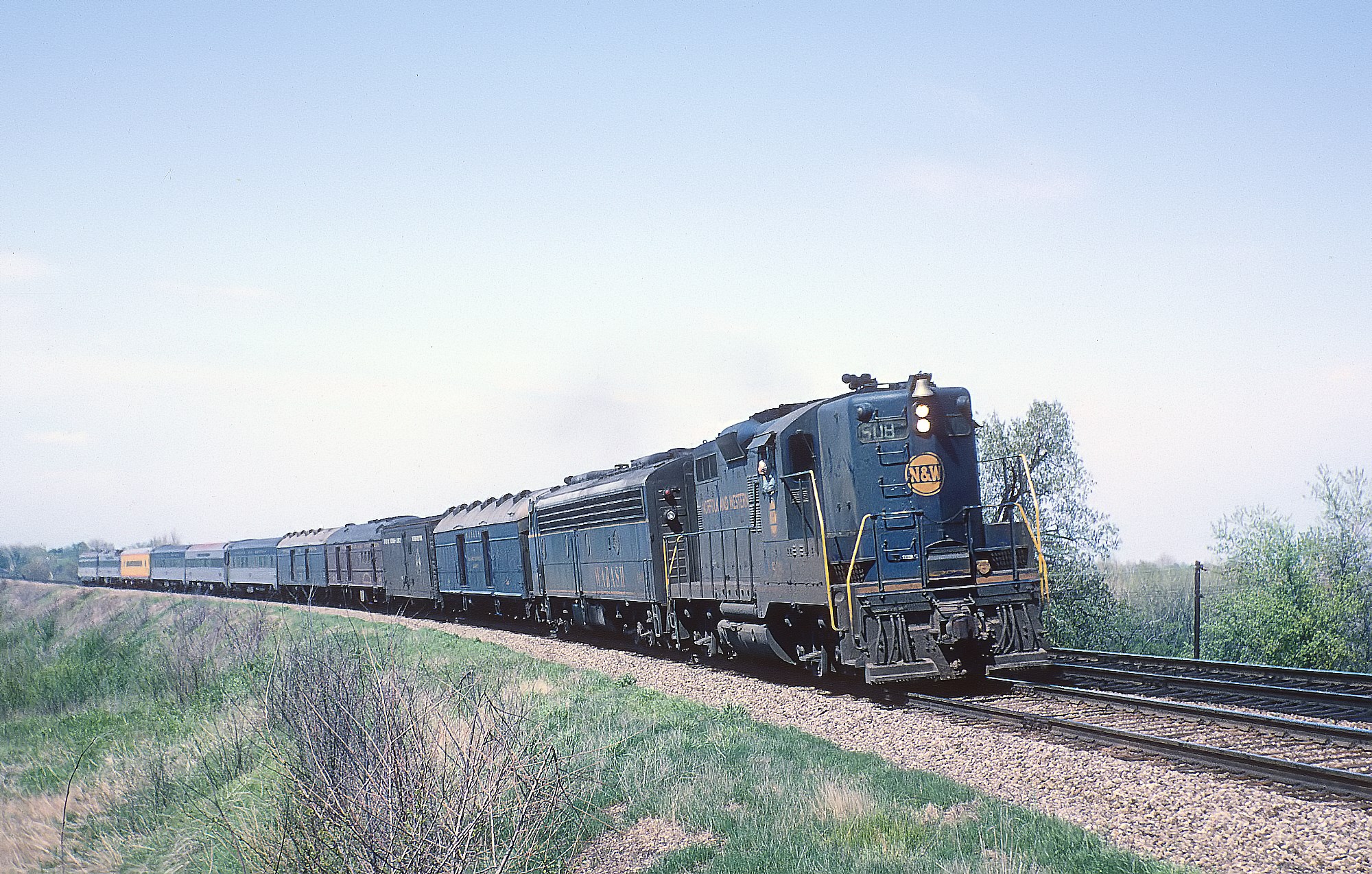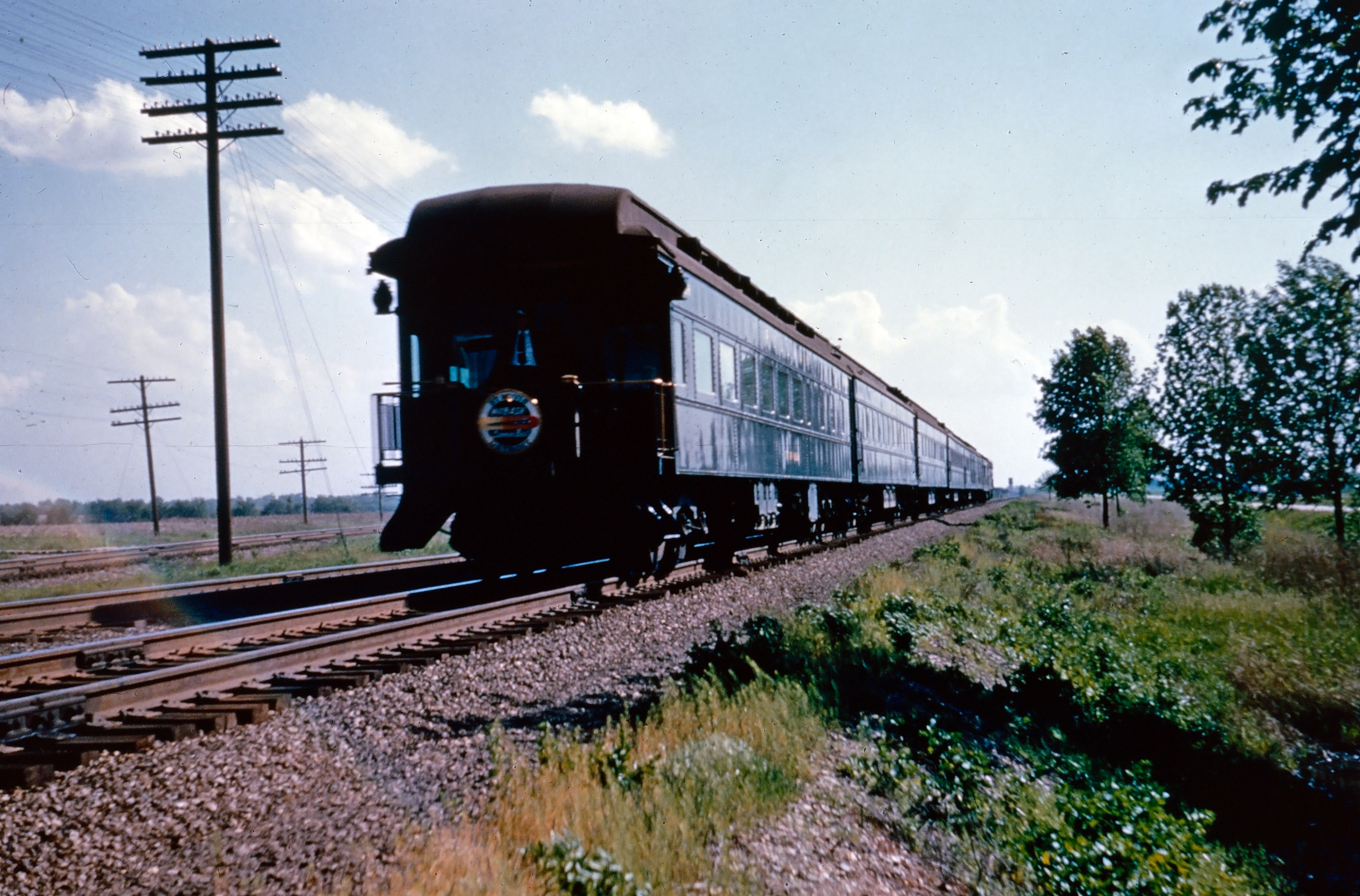The "Wabash Cannon Ball"
Last revised: September 15, 2024
By: Adam Burns
The Wabash Cannon Ball was a fast express train on the Wabash Railroad, and continued by successor Norfolk and Western.
Named after the popular folk song, it operated from 1950 to 1971, providing passenger service between Detroit, Michigan, and St. Louis, Missouri. The train was known for its speed and luxury, featuring amenities such as air conditioning, dining cars, and sleeping quarters.
While the origins of this name can be traced as far back as the 19th century, the modern incarnation was launched in 1950 following the folk song's popularity.
Photos
 Wabash E8A #1012 has train #4, the eastbound "Wabash Cannon Ball," arriving at Tolono, Illinois on October 28, 1962. Roger Puta photo.
Wabash E8A #1012 has train #4, the eastbound "Wabash Cannon Ball," arriving at Tolono, Illinois on October 28, 1962. Roger Puta photo.Inauguration
In his book, "More Classic American Railroads," author Mike Schafer notes the Wabash first attached the name Wabash Cannon Ball to its Detroit-St. Louis day trains in 1949. It was the first time the railroad had applied the moniker to an actual train.
Embarking on a breathtaking journey across the heart of the Wabsh system from St. Louis to Detroit. This route was meticulously designed, crossing a unique tapestry of landscapes that encapsulated the heart and spirit of America.
The inception of the Wabash Cannon Ball was intriguingly linked with the popular song "Wabash Cannonball". The song was recorded by various artists over the decades, including Roy Acuff, who notably popularized it in 1936.
Accommodations
Its widespread success stirred the creative wheels at the Wabash, which christened its passenger train service after the song, thus engraining the Wabash Cannon Ball into the physical and cultural landscape of the country.
Aboard the train, passengers were treated to a variety of services aimed at ensuring a pleasant and memorable journey. The on-board accommodations were modest but quite comfortable. In 1952 they included an observation parlor (with drawing room), a diner-lounge, chair cars, and reclining seat coaches.
From comfortable seating in both coach and first-class cars to exquisite dining service, each ride on the Wabash Cannon Ball encapsulated an exciting voyage across the American Midwest.
The train made several stops along its 488.8 mile route including Fort Wayne, Huntington, Peru, Logansport, Lafayette, Danville, and Decatur while arrivals and departure occurred at St. Louis Union Station and Detroit's Fort Street Union Depot. As an eastbound train, it bore number 4, while its westbound counterpart was designated number 3.
Timetable and Consist (1952)

Norfolk & Western
The Wabash Cannon Ball owed a substantial part of its existence to the Detroit Special and the St. Louis Special. These predecessor trains laid the groundwork, fostering the route and logistical infrastructure necessary for the launch and continuance of the Wabash Cannon Ball.
On October 16, 1964 the Norfolk & Western acquired the Wabash. Despite the transition in ownership, and the N&W's attempts to discontinue the train's name in the mid 1960s - as well as the service itself a few years later - public outcry saved the Cannon Ball until the start of Amtrak.
The turn of the decade came with the end of an era. The Wabash Cannon Ball ceased operations on April 30, 1971. While the exact date marked the closure of a remarkable journey, it also opened new avenues of nostalgia, legacy, and historical preservation.
 Norfolk & Western GP9 #508 has Train #1, the "Wabash Cannon Ball," crosses the Sagamon River south of Decatur, Illinois in May, 1966. Rick Burn photo.
Norfolk & Western GP9 #508 has Train #1, the "Wabash Cannon Ball," crosses the Sagamon River south of Decatur, Illinois in May, 1966. Rick Burn photo.Legacy
The Wabash Cannon Ball, much like its celebrated name, was a testament to the harmonious blend of culture and technology. Its legacy outlasted its operational span, as the grandeur of its historical voyage continued to captivate the imagination of railroad enthusiasts and historians alike.
While its services were modest it nevertheless painted a picture of luxurious travel. On this legendary train, the journey was just as immersive as the destination, with each voyage transforming into a delightful rendezvous with comfort and elegance.
At its heart, the Wabash Cannon Ball was a cultural phenomenon. Its existence, spurred by a popular song, catapulted a routine train service into a living embodiment of public sentiment and regional pride.
Its connection with St. Louis and Detroit - a manufacturing powerhouse and a gateway to the west respectively - allowed it to stitch together the disparate economies and fostered a sense of unity amongst its travelers.
Despite operating for just under three decades, the Wabash Cannon Ball’s importance to American railroad history remains undiminished. Its service, span, and cultural significance have sealed its place within the annals of the country's rich rail history.
It was not just a train, but a symbol of an era. It represented the seamless intertwining of technology and human spirit, the embracing of progress, and nostalgia for a simpler past.
As a precursor to the Norfolk and Western's acquisition, the train played a significant role in setting the stage for transformative changes in regional and intra-city train services – an inspiration that continues to resonate within the industry today.
The train's namesake song, the "Wabash Cannonball," continues to act as a melodic metaphor for the train’s legacy. Its rhythmic testament to the train's flamboyance, resilience and grandeur embellishes the narrative of the train.
The Wabash Cannon Ball, while no longer thundering across the tracks, lives on in the collective memory of America. The distinct rhythm of tracks under its wheels, the echoing whistle cutting through the heartland, the sight of its streamlined form rushing towards the next destination – all continue to inspire artists and storytellers.
The train's end was not spurred by a decline in popularity or practicality but was a consequence of larger industry-wide shifts towards modernized, high-speed services. This, combined with rising operational costs and decreasing profit margins, led to its eventual retirement.
In September, 1967 the U.S. Postal Service ended all "mail by rail" contracts, and instead moved this freight by either truck or air lines. It was the final blow to privately operated passenger rail services as most of the industry wanted out, which led to Amtrak's creation on May 1, 1971.
 The heavyweight observation-parlor brings up the tail end of the "Wabash Cannon Ball" at Litchfield, Illinois on May 4, 1955. Photographer unknown. American-Rails.com collection.
The heavyweight observation-parlor brings up the tail end of the "Wabash Cannon Ball" at Litchfield, Illinois on May 4, 1955. Photographer unknown. American-Rails.com collection.Through its service, the Wabash Cannon Ball underlined the importance of connectivity. It played an integral role in economic functions by transporting goods and passengers, spurred social connections by moving people across states, and provided a platform for the shared cultural experience of traversing America.
In summary, the Wabash Cannon Ball's significance persists in its symbolization of rail travel's romantic era. Through its network, services, and culture, it ensured that the essence of the journey exceeded the destination.
From its memorialization in song to its tangible imprint on American railroads, the train remains an iconic testament to the power and majesty of trains.
Sources
- Grant, Roger H. "Follow The Flag": A History Of The Wabash Railroad Company. DeKalb: Northern Illinois University Press, 2004.
- Heimburger, Donald J. Wabash. Forest Park: Heimburger House Publishing Company, 1984.
- Schafer, Mike. More Classic American Railroads. Osceola: MBI Publishing, 2000.
- Schafer, Mike and Welsh, Joe. Streamliners, History of a Railroad Icon. St. Paul: MBI Publishing, 2003.
Recent Articles
-
Montana Dinner Train Rides Near Lewistown!
Jan 08, 26 03:03 PM
The Charlie Russell Chew Choo turns an ordinary rail trip into an evening event: scenery, storytelling, live entertainment, and a hearty dinner served as the train rumbles across trestles and into a t… -
Alabama's - Murder Mystery - Dinner Train Rides
Jan 08, 26 02:19 PM
There is currently one location in the state offering a murder mystery dinner experience, the Wales West Light Railway! -
Rhode Island's - Murder Mystery - Dinner Train Rides
Jan 08, 26 01:43 PM
Let's dive into the enigmatic world of murder mystery dinner train rides in Rhode Island, where each journey promises excitement, laughter, and a challenge for your inner detective. -
Florida's - Wine Tasting - Train Rides
Jan 08, 26 01:13 PM
Wine by train not only showcases the beauty of Florida's lesser-known regions but also celebrate the growing importance of local wineries and vineyards. -
Texas's - Wine Tasting - Train Rides
Jan 08, 26 12:30 PM
This article invites you on a metaphorical journey through some of these unique wine tasting train experiences in Texas. -
New York's - Wine Tasting - Train Rides
Jan 08, 26 11:32 AM
This article will delve into the history, offerings, and appeal of wine tasting trains in New York, guiding you through a unique experience that combines the romance of the rails with the sophisticati… -
California Dinner Train Rides In Sacramento!
Jan 08, 26 11:21 AM
Just minutes from downtown Sacramento, the River Fox Train has carved out a niche that’s equal parts scenic railroad, social outing, and “pick-your-own-adventure” evening on the rails. -
New Jersey Dinner Train Rides In Woodstown!
Jan 08, 26 10:31 AM
For visitors who love experiences (not just attractions), Woodstown Central’s dinner-and-dining style trains have become a signature offering—especially for couples’ nights out, small friend groups, a… -
Nevada's - Murder Mystery - Dinner Train Rides
Jan 07, 26 02:12 PM
Seamlessly blending the romance of train travel with the allure of a theatrical whodunit, these excursions promise suspense, delight, and an unforgettable journey through Nevada’s heart. -
West Virginia's - Murder Mystery - Dinner Train Rides
Jan 07, 26 02:08 PM
For those looking to combine the allure of a train ride with an engaging whodunit, the murder mystery dinner trains offer a uniquely thrilling experience. -
Kansas's - Murder Mystery - Dinner Train Rides
Jan 07, 26 01:53 PM
Kansas, known for its sprawling wheat fields and rich history, hides a unique gem that promises both intrigue and culinary delight—murder mystery dinner trains. -
Michigan's - Wine Tasting - Train Rides
Jan 07, 26 12:36 PM
In this article, we’ll delve into the world of Michigan’s wine tasting train experiences that cater to both wine connoisseurs and railway aficionados. -
Indiana's - Wine Tasting - Train Rides
Jan 07, 26 12:33 PM
In this article, we'll delve into the experience of wine tasting trains in Indiana, exploring their routes, services, and the rising popularity of this unique adventure. -
South Dakota's - Wine Tasting - Train Rides
Jan 07, 26 12:30 PM
For wine enthusiasts and adventurers alike, South Dakota introduces a novel way to experience its local viticulture: wine tasting aboard the Black Hills Central Railroad. -
Kentucky Thomas The Train Rides
Jan 07, 26 12:26 PM
If you’ve got a Thomas fan in the house, Day Out With Thomas at the Kentucky Railway Museum is one of those “circle it on the calendar” weekends. -
Michigan's Thomas The Train Rides
Jan 07, 26 12:10 PM
If you’ve got a Thomas fan in the house, few spring outings feel as “storybook-real” as Day Out With Thomas™ at Greenfield Village in Dearborn, Michigan. -
Texas Dinner Train Rides On The TSR!
Jan 07, 26 11:36 AM
Today, TSR markets itself as a round-trip, four-hour, 25-mile journey between Palestine and Rusk—an easy day trip (or date-night centerpiece) with just the right amount of history baked in. -
Iowa Dinner Train Rides In Boone!
Jan 07, 26 11:06 AM
If you’ve ever wished you could pair a leisurely rail journey with a proper sit-down meal—white tablecloths, big windows, and countryside rolling by—the Boone & Scenic Valley Railroad & Museum in Boon… -
Wisconsin Dinner Train Rides In North Freedom!
Jan 06, 26 10:18 PM
Featured here is a practical guide to Mid-Continent’s dining train concept—what the experience is like, the kinds of menus the museum has offered, and what to expect when you book. -
Pennsylvania Dinner Train Rides In Boyertown!
Jan 06, 26 06:48 PM
With beautifully restored vintage equipment, carefully curated menus, and theatrical storytelling woven into each trip, the Colebrookdale Railroad offers far more than a simple meal on rails.

















